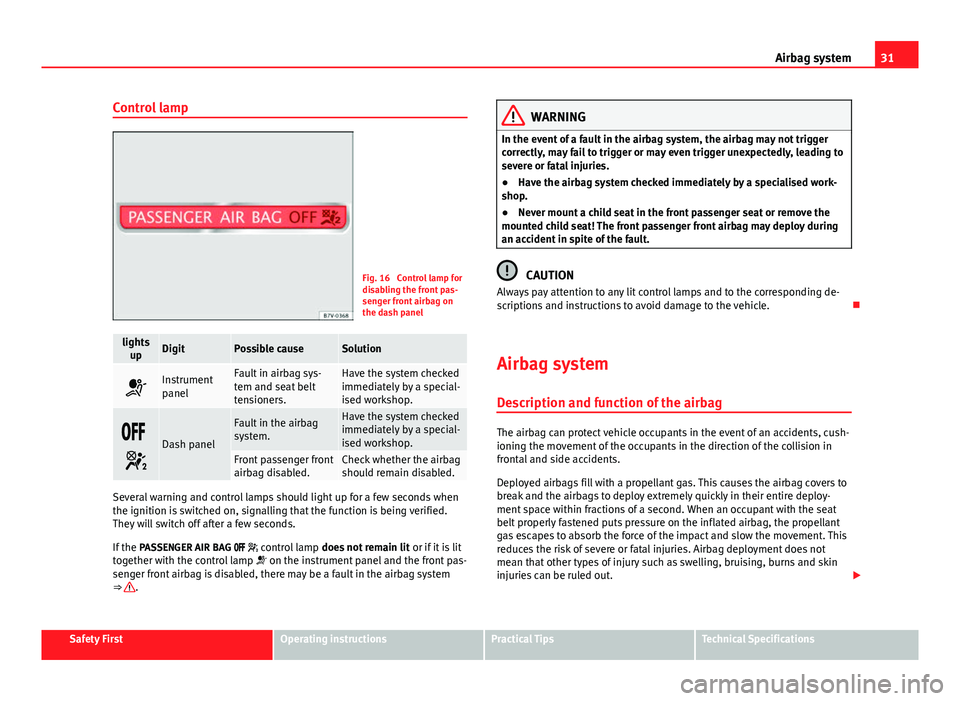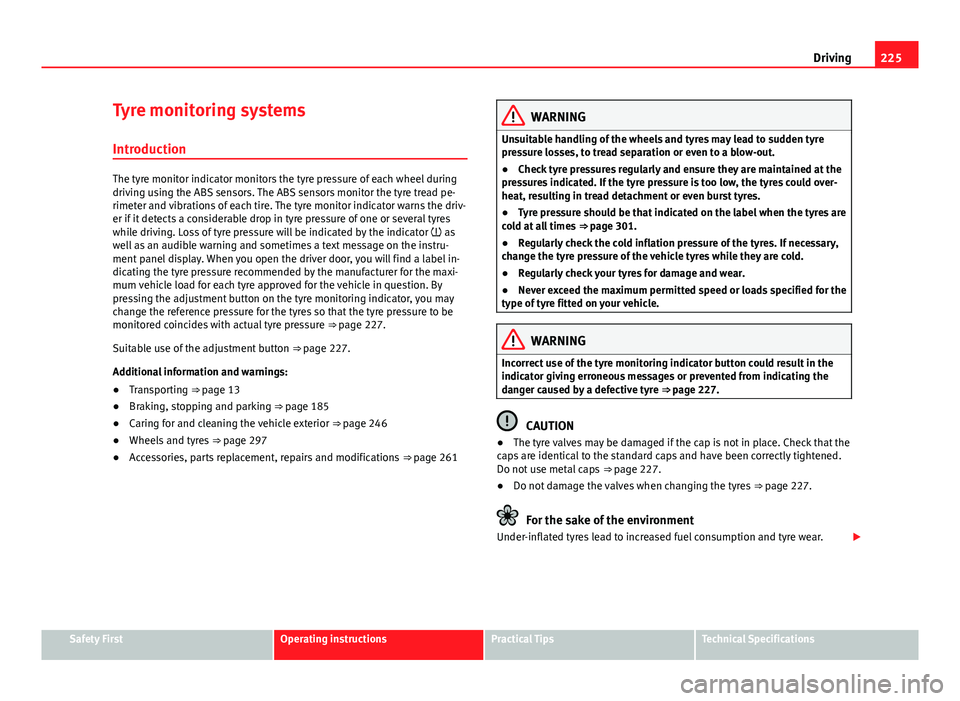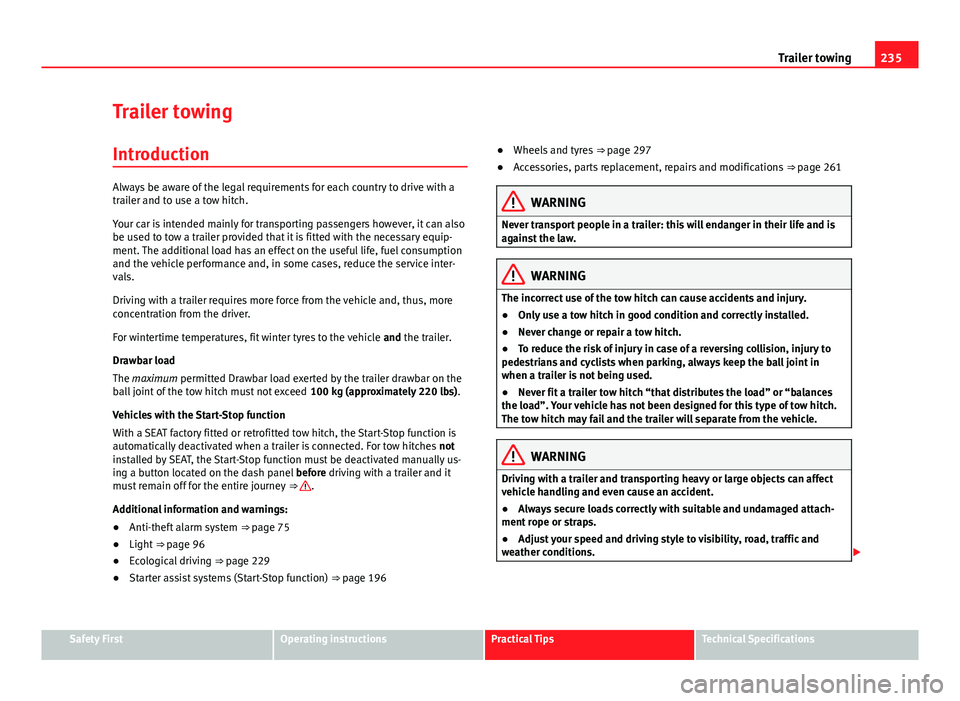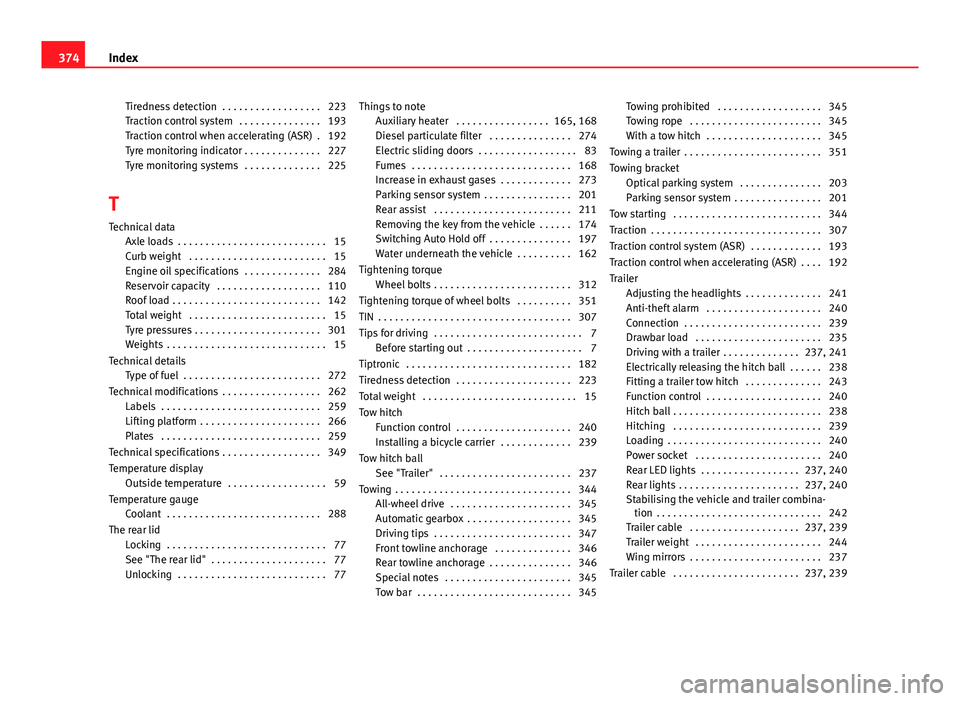tire type Seat Alhambra 2014 Owner's Manual
[x] Cancel search | Manufacturer: SEAT, Model Year: 2014, Model line: Alhambra, Model: Seat Alhambra 2014Pages: 381, PDF Size: 5.75 MB
Page 33 of 381

31
Airbag system
Control lamp
Fig. 16 Control lamp for
disabling the front pas-
senger front airbag on
the dash panel
lights upDigitPossible causeSolution
Instrument
panelFault in airbag sys-
tem and seat belt
tensioners.Have the system checked
immediately by a special-
ised workshop.
Dash panel
Fault in the airbag
system.Have the system checked
immediately by a special-
ised workshop.
Front passenger front
airbag disabled.Check whether the airbag
should remain disabled.
Several warning and control lamps should light up for a few seconds when
the ignition is switched on, signalling that the function is being verified.
They will switch off after a few seconds.
If the PASSENGER AIR BAG control lamp does not remain lit or if it is lit
together with the control lamp on the instrument panel and the front pas-
senger front airbag is disabled, there may be a fault in the airbag system
⇒
.
WARNING
In the event of a fault in the airbag system, the airbag may not trigger
correctly, may fail to trigger or may even trigger unexpectedly, leading to
severe or fatal injuries.
● Have the airbag system checked immediately by a specialised work-
shop.
● Never mount a child seat in the front passenger seat or remove the
mounted child seat! The front passenger front airbag may deploy during
an accident in spite of the fault.
CAUTION
Always pay attention to any lit control lamps and to the corresponding de-
scriptions and instructions to avoid damage to the vehicle.
Airbag system Description and function of the airbag
The airbag can protect vehicle occupants in the event of an accidents, cush-
ioning the movement of the occupants in the direction of the collision in
frontal and side accidents.
Deployed airbags fill with a propellant gas. This causes the airbag covers to
break and the airbags to deploy extremely quickly in their entire deploy-
ment space within fractions of a second. When an occupant with the seat
belt properly fastened puts pressure on the inflated airbag, the propellant
gas escapes to absorb the force of the impact and slow the movement. This
reduces the risk of severe or fatal injuries. Airbag deployment does not
mean that other types of injury such as swelling, bruising, burns and skin
injuries can be ruled out.
Safety FirstOperating instructionsPractical TipsTechnical Specifications
Page 227 of 381

225
Driving
Tyre monitoring systems Introduction
The tyre monitor indicator monitors the tyre pressure of each wheel during
driving using the ABS sensors. The ABS sensors monitor the tyre tread pe-
rimeter and vibrations of each tire. The tyre monitor indicator warns the driv-
er if it detects a considerable drop in tyre pressure of one or several tyres
while driving. Loss of tyre pressure will be indicated by the indicator as
well as an audible warning and sometimes a text message on the instru-
ment panel display. When you open the driver door, you will find a label in-
dicating the tyre pressure recommended by the manufacturer for the maxi-
mum vehicle load for each tyre approved for the vehicle in question. By
pressing the adjustment button on the tyre monitoring indicator, you may
change the reference pressure for the tyres so that the tyre pressure to be
monitored coincides with actual tyre pressure ⇒ page 227.
Suitable use of the adjustment button ⇒ page 227.
Additional information and warnings:
● Transporting ⇒ page 13
● Braking, stopping and parking ⇒ page 185
● Caring for and cleaning the vehicle exterior ⇒ page 246
● Wheels and tyres ⇒ page 297
● Accessories, parts replacement, repairs and modifications ⇒ page 261
WARNING
Unsuitable handling of the wheels and tyres may lead to sudden tyre
pressure losses, to tread separation or even to a blow-out.
● Check tyre pressures regularly and ensure they are maintained at the
pressures indicated. If the tyre pressure is too low, the tyres could over-
heat, resulting in tread detachment or even burst tyres.
● Tyre pressure should be that indicated on the label when the tyres are
cold at all times ⇒ page 301.
● Regularly check the cold inflation pressure of the tyres. If necessary,
change the tyre pressure of the vehicle tyres while they are cold.
● Regularly check your tyres for damage and wear.
● Never exceed the maximum permitted speed or loads specified for the
type of tyre fitted on your vehicle.
WARNING
Incorrect use of the tyre monitoring indicator button could result in the
indicator giving erroneous messages or prevented from indicating the
danger caused by a defective tyre ⇒ page 227.
CAUTION
● The tyre valves may be damaged if the cap is not in place. Check that the
caps are identical to the standard caps and have been correctly tightened.
Do not use metal caps ⇒ page 227.
● Do not damage the valves when changing the tyres ⇒ page 227.
For the sake of the environment
Under-inflated tyres lead to increased fuel consumption and tyre wear.
Safety FirstOperating instructionsPractical TipsTechnical Specifications
Page 237 of 381

235
Trailer towing
Trailer towing Introduction
Always be aware of the legal requirements for each country to drive with a
trailer and to use a tow hitch.
Your car is intended mainly for transporting passengers however, it can also
be used to tow a trailer provided that it is fitted with the necessary equip-
ment. The additional load has an effect on the useful life, fuel consumption
and the vehicle performance and, in some cases, reduce the service inter-
vals.
Driving with a trailer requires more force from the vehicle and, thus, more
concentration from the driver.
For wintertime temperatures, fit winter tyres to the vehicle and the trailer.
Drawbar load
The maximum permitted Drawbar load exerted by the trailer drawbar on the
ball joint of the tow hitch must not exceed 100 kg (approximately 220 lbs).
Vehicles with the Start-Stop function
With a SEAT factory fitted or retrofitted tow hitch, the Start-Stop function is
automatically deactivated when a trailer is connected. For tow hitches not
installed by SEAT, the Start-Stop function must be deactivated manually us-
ing a button located on the dash panel before driving with a trailer and it
must remain off for the entire journey ⇒
.
Additional information and warnings:
● Anti-theft alarm system ⇒ page 75
● Light ⇒ page 96
● Ecological driving ⇒ page 229
● Starter assist systems (Start-Stop function) ⇒ page 196●
Wheels and tyres ⇒ page 297
● Accessories, parts replacement, repairs and modifications ⇒ page 261
WARNING
Never transport people in a trailer: this will endanger in their life and is
against the law.
WARNING
The incorrect use of the tow hitch can cause accidents and injury.
● Only use a tow hitch in good condition and correctly installed.
● Never change or repair a tow hitch.
● To reduce the risk of injury in case of a reversing collision, injury to
pedestrians and cyclists when parking, always keep the ball joint in
when a trailer is not being used.
● Never fit a trailer tow hitch “that distributes the load” or “balances
the load”. Your vehicle has not been designed for this type of tow hitch.
The tow hitch may fail and the trailer will separate from the vehicle.
WARNING
Driving with a trailer and transporting heavy or large objects can affect
vehicle handling and even cause an accident.
● Always secure loads correctly with suitable and undamaged attach-
ment rope or straps.
● Adjust your speed and driving style to visibility, road, traffic and
weather conditions.
Safety FirstOperating instructionsPractical TipsTechnical Specifications
Page 376 of 381

Tiredness detection . . . . . . . . . . . . . . . . . . 223
Traction control system . . . . . . . . . . . . . . . 193
Traction control when accelerating (ASR) . 192
Tyre monitoring indicator . . . . . . . . . . . . . . 227
Tyre monitoring systems . . . . . . . . . . . . . . 225
T Technical data Axle loads . . . . . . . . . . . . . . . . . . . . . . . . . . . 15
Curb weight . . . . . . . . . . . . . . . . . . . . . . . . . 15
Engine oil specifications . . . . . . . . . . . . . . 284
Reservoir capacity . . . . . . . . . . . . . . . . . . . 110
Roof load . . . . . . . . . . . . . . . . . . . . . . . . . . . 142
Total weight . . . . . . . . . . . . . . . . . . . . . . . . . 15
Tyre pressures . . . . . . . . . . . . . . . . . . . . . . . 301
Weights . . . . . . . . . . . . . . . . . . . . . . . . . . . . . 15
Technical details Type of fuel . . . . . . . . . . . . . . . . . . . . . . . . . 272
Technical modifications . . . . . . . . . . . . . . . . . . 262 Labels . . . . . . . . . . . . . . . . . . . . . . . . . . . . . 259
Lifting platform . . . . . . . . . . . . . . . . . . . . . . 266
Plates . . . . . . . . . . . . . . . . . . . . . . . . . . . . . 259
Technical specifications . . . . . . . . . . . . . . . . . . 349
Temperature display Outside temperature . . . . . . . . . . . . . . . . . . 59
Temperature gauge Coolant . . . . . . . . . . . . . . . . . . . . . . . . . . . . 288
The rear lid Locking . . . . . . . . . . . . . . . . . . . . . . . . . . . . . 77
See "The rear lid" . . . . . . . . . . . . . . . . . . . . . 77
Unlocking . . . . . . . . . . . . . . . . . . . . . . . . . . . 77 Things to note
Auxiliary heater . . . . . . . . . . . . . . . . . 165, 168
Diesel particulate filter . . . . . . . . . . . . . . . 274
Electric sliding doors . . . . . . . . . . . . . . . . . . 83
Fumes . . . . . . . . . . . . . . . . . . . . . . . . . . . . . 168
Increase in exhaust gases . . . . . . . . . . . . . 273
Parking sensor system . . . . . . . . . . . . . . . . 201
Rear assist . . . . . . . . . . . . . . . . . . . . . . . . . 211
Removing the key from the vehicle . . . . . . 174
Switching Auto Hold off . . . . . . . . . . . . . . . 197
Water underneath the vehicle . . . . . . . . . . 162
Tightening torque Wheel bolts . . . . . . . . . . . . . . . . . . . . . . . . . 312
Tightening torque of wheel bolts . . . . . . . . . . 351
TIN . . . . . . . . . . . . . . . . . . . . . . . . . . . . . . . . . . . 307
Tips for driving . . . . . . . . . . . . . . . . . . . . . . . . . . . 7 Before starting out . . . . . . . . . . . . . . . . . . . . . 7
Tiptronic . . . . . . . . . . . . . . . . . . . . . . . . . . . . . . 182
Tiredness detection . . . . . . . . . . . . . . . . . . . . . 223
Total weight . . . . . . . . . . . . . . . . . . . . . . . . . . . . 15
Tow hitch Function control . . . . . . . . . . . . . . . . . . . . . 240
Installing a bicycle carrier . . . . . . . . . . . . . 239
Tow hitch ball See "Trailer" . . . . . . . . . . . . . . . . . . . . . . . . 237
Towing . . . . . . . . . . . . . . . . . . . . . . . . . . . . . . . . 344 All-wheel drive . . . . . . . . . . . . . . . . . . . . . . 345
Automatic gearbox . . . . . . . . . . . . . . . . . . . 345
Driving tips . . . . . . . . . . . . . . . . . . . . . . . . . 347
Front towline anchorage . . . . . . . . . . . . . . 346
Rear towline anchorage . . . . . . . . . . . . . . . 346
Special notes . . . . . . . . . . . . . . . . . . . . . . . 345
Tow bar . . . . . . . . . . . . . . . . . . . . . . . . . . . . 345 Towing prohibited . . . . . . . . . . . . . . . . . . . 345
Towing rope . . . . . . . . . . . . . . . . . . . . . . . . 345
With a tow hitch . . . . . . . . . . . . . . . . . . . . . 345
Towing a trailer . . . . . . . . . . . . . . . . . . . . . . . . . 351
Towing bracket Optical parking system . . . . . . . . . . . . . . . 203
Parking sensor system . . . . . . . . . . . . . . . . 201
Tow starting . . . . . . . . . . . . . . . . . . . . . . . . . . . 344
Traction . . . . . . . . . . . . . . . . . . . . . . . . . . . . . . . 307
Traction control system (ASR) . . . . . . . . . . . . . 193
Traction control when accelerating (ASR) . . . . 192
Trailer Adjusting the headlights . . . . . . . . . . . . . . 241
Anti-theft alarm . . . . . . . . . . . . . . . . . . . . . 240
Connection . . . . . . . . . . . . . . . . . . . . . . . . . 239
Drawbar load . . . . . . . . . . . . . . . . . . . . . . . 235
Driving with a trailer . . . . . . . . . . . . . . 237, 241
Electrically releasing the hitch ball . . . . . . 238
Fitting a trailer tow hitch . . . . . . . . . . . . . . 243
Function control . . . . . . . . . . . . . . . . . . . . . 240
Hitch ball . . . . . . . . . . . . . . . . . . . . . . . . . . . 238
Hitching . . . . . . . . . . . . . . . . . . . . . . . . . . . 239
Loading . . . . . . . . . . . . . . . . . . . . . . . . . . . . 240
Power socket . . . . . . . . . . . . . . . . . . . . . . . 240
Rear LED lights . . . . . . . . . . . . . . . . . . 237, 240
Rear lights . . . . . . . . . . . . . . . . . . . . . . 237, 240
Stabilising the vehicle and trailer combina-tion . . . . . . . . . . . . . . . . . . . . . . . . . . . . . . 242
Trailer cable . . . . . . . . . . . . . . . . . . . . 237, 239
Trailer weight . . . . . . . . . . . . . . . . . . . . . . . 244
Wing mirrors . . . . . . . . . . . . . . . . . . . . . . . . 237
Trailer cable . . . . . . . . . . . . . . . . . . . . . . . 237, 239
374 Index